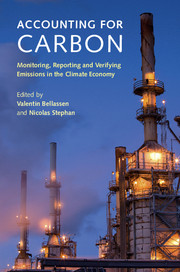Book contents
- Frontmatter
- Contents
- List of figures and map
- List of tables
- List of boxes
- Notes on contributors
- Acknowledgements
- 1 Introduction: key notions and trade-offs involved in MRVing emissions
- Part I MRV of territorial/jurisdictional emissions
- 2 Trendsetter for territorial schemes: national GHG inventories under the UNFCCC
- 3 Variant 1: region/city geographical inventories
- 4 Variant 2: sectoral MRV at the jurisdictional level–forestry (REDD+) in the VCS and the UNFCCC
- Part II MRV of industrial sites and entities
- Part III MRV at offset project scale
- Index
- References
4 - Variant 2: sectoral MRV at the jurisdictional level–forestry (REDD+) in the VCS and the UNFCCC
from Part I - MRV of territorial/jurisdictional emissions
Published online by Cambridge University Press: 05 March 2015
- Frontmatter
- Contents
- List of figures and map
- List of tables
- List of boxes
- Notes on contributors
- Acknowledgements
- 1 Introduction: key notions and trade-offs involved in MRVing emissions
- Part I MRV of territorial/jurisdictional emissions
- 2 Trendsetter for territorial schemes: national GHG inventories under the UNFCCC
- 3 Variant 1: region/city geographical inventories
- 4 Variant 2: sectoral MRV at the jurisdictional level–forestry (REDD+) in the VCS and the UNFCCC
- Part II MRV of industrial sites and entities
- Part III MRV at offset project scale
- Index
- References
Summary
Context
Ever since avoided deforestation came back on the agenda of international climate negotiations in Montreal in 2005, there has been a forefeeling that only a large-scale approach, national or jurisdictional, would eventually be acceptable. This was confirmed by the 16th Conference of the Parties in 2010 (Decision 1/CP.16), and this is the approach that the World Bank has been pursuing with its Forest Carbon Partnership Facility (FCPF). Accordingly, the Verified Carbon Standard (VCS) – the leading standard for REDD+ (Reduction of Emissions from Deforestation and Degradation of Forests and the role of conservation, sustainable management and enhancement of forest carbon stocks) projects in 2012 – has been trying to upscale its project-scale approach over the last couple of years. This resulted in the Jurisdictional and Nested REDD+ (JNR) Framework which undertook public consultation in 2012 and was officially released in 2013.
The Verified Carbon Standard (VCS) is one of the most widely used standards in the voluntary market, with 55 percent of transacted credits (56 MtCO2e) according to Peters-Stanley et al. (2013). So far, however, all these credits have been coming from individual projects, including those that allow for the REDD+. As of October 1st, 2013, the JNR was still too recent and the first programs and credits to pass it had still to materialize. Yet, eight pilot programs (at the national and regional level) using these requirements were being developed. Five of these pilot programs are funded by a US$1.4 million grant from the Norwegian International Climate and Forest Initiative (NICFI) given to the VCS over a three-year period (2013–2015) to develop and pilot integrated JNR accounting and verification frameworks.
As such, it was at that time the most operational MRV framework for jurisdictional REDD+, and to our knowledge, the most advanced sectoral MRV framework. This is why it has been chosen as a “variant” from national greenhouse gas inventories for MRV at territorial scale in this chapter.
- Type
- Chapter
- Information
- Accounting for CarbonMonitoring, Reporting and Verifying Emissions in the Climate Economy, pp. 104 - 136Publisher: Cambridge University PressPrint publication year: 2015

